
The granny knot is a binding knot, used to secure a rope or line around an object. It is considered inferior to the reef knot, which it superficially resembles. Neither of these knots should be used as a bend knot for attaching two ropes together.
The granny knot is also called the false, lubber's, calf, and booby knot. Patterson's Nautical Encyclopedia calls it "old granny knot" and Sir Edwin Arnold calls it the "common or garden knot." The name granny is given in Vocabulary of Sea Phrases and Roding pictures the knot in 1795.
The granny consists of two identical half knots, one tied on top of the other. It has but one practical purpose that I know of and that is to serve as a surgeon's knot. Formerly it was employed for tying up parcels in five-and-ten-cent stores, but the practice was given up and paper bags substituted as they were found to be simpler.

Edward Doubleday was an English entomologist primarily interested in Lepidoptera. He is best known for The Genera of Diurnal Lepidoptera: Comprising Their Generic Characters, a Notice of Their Habits and Transformations, and a Catalogue of the Species of Each Genus, co-written with John O. Westwood, and illustrated by William Chapman Hewitson; and List of the Specimens of Lepidopterous Insects in the Collection of the British Museum.

The Satyrini is one of the tribes of the subfamily Satyrinae. It includes about 2200 species and is therefore the largest tribe in the subfamily which comprises 2500 species.
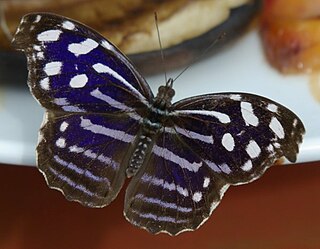
Biblidinae is a subfamily of nymphalid butterflies that includes the tropical brushfoots. This subfamily was sometimes merged within the Limenitidinae, but they are now recognized as quite distinct lineages. In older literature, this subfamily is sometimes called Eurytelinae.

Kallima philarchus, the Ceylon blue oakleaf, is a nymphalid butterfly found in Sri Lanka. With wings closed, it closely resembles a dry leaf with dark veins and is a spectacular example of camouflage.
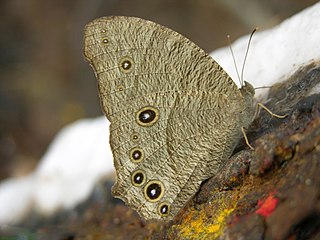
The Melanitini are one of the smaller tribes of the Satyrinae in the Nymphalidae family. They contain the following genera:
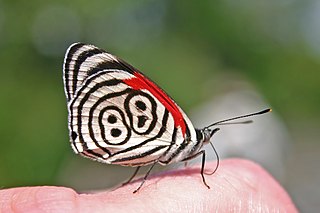
Diaethria is a brush-footed butterfly genus found in the Neotropical realm, ranging from Mexico to Paraguay.
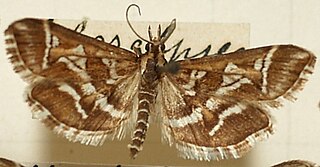
Diasemia is a genus of moths in the family Crambidae.

Kallima, known as the oakleaf or oak leaf butterflies, is a genus of butterflies of the subfamily Nymphalinae in the family Nymphalidae. They are found in east, south and southeast Asia. Their common name is a reference to the lower surface of their wings, which is various shades of brown like a dead leaf.

Coeini is a tribe of brush-footed butterflies. Its members are found in the Neotropical realm.

Baeotus is a genus of butterflies in the family Nymphalidae found in Central America, the Caribbean, and South America.
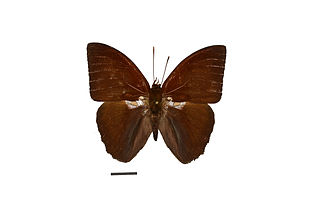
Narope is a genus of Neotropical butterflies in family Nymphalidae, and includes species that present inconspicuously marking patterns on the wings. The genus includes 16 species.
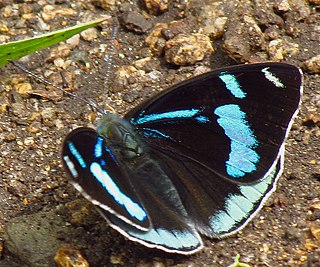
Perisama is a brush-footed butterfly genus found in the Neotropical realm, ranging from Colombia and Venezuela to Argentina.
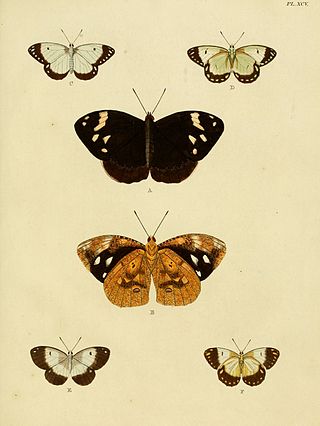
Dynastor is a genus of butterflies in the family Nymphalidae. Members of the genus can be found from Mexico to Central and South America.
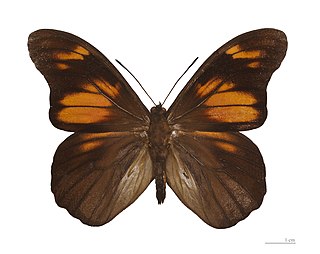
Penetes is a monotypic butterfly genus in the family Nymphalidae. Its single species Penetes pamphanis is a large butterfly native to south-eastern Brazil.

Opsiphanes is a genus of butterflies of the family Nymphalidae found from Mexico to South America.
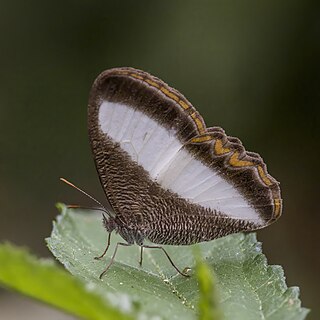
Oressinoma is a Neotropical genus of butterflies in the family Nymphalidae.

Haematera pyrame is a South American species of butterflies belonging to the family Nymphalidae. It was first described by Johan Christian Fabricius in 1781 under the name Papilio pyramus, which was preoccupied. Jacob Hübner designated a slightly modified replacement name. As currently prescribed, it is the only species in the genus Haematera.

John Doubleday was a British craftsperson, restorer, and dealer in antiquities who was employed by the British Museum for the last 20 years of his life. He undertook several duties for the museum, not least as a witness in criminal trials, but was primarily their specialist restorer, perhaps the first person to hold the position. He is best known for his 1845 restoration of the severely-damaged Roman Portland Vase, an accomplishment that places him at the forefront of his profession at the time.

Nomophilini is a tribe of the species-rich subfamily Spilomelinae in the pyraloid moth family Crambidae. The tribe was erected by Vladimir Ivanovitsch Kuznetzov and Alexandr A. Stekolnikov in 1979.





















